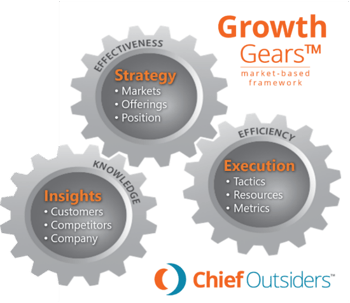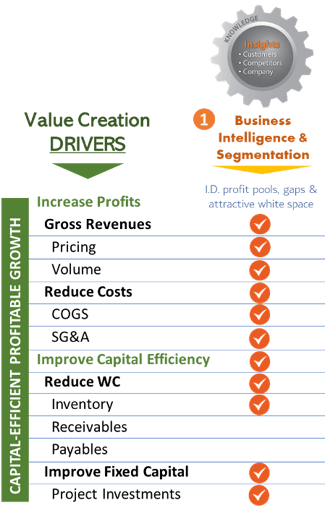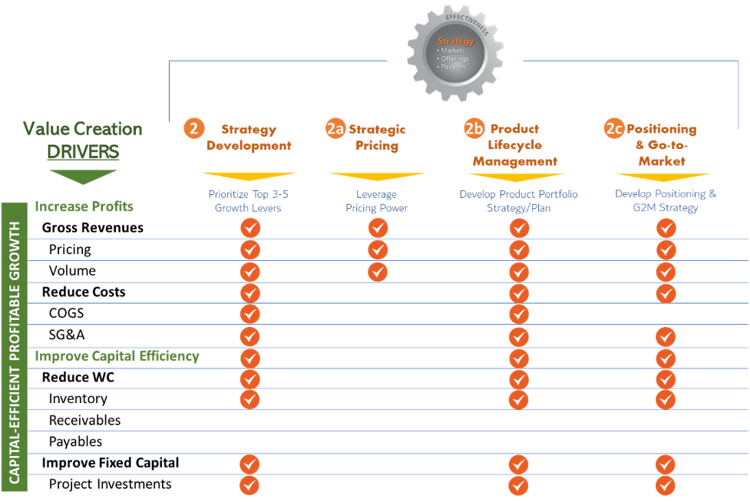
Apply Growth Gears Marketing in Early Post-Acquisition to Maximize PE Value Creation
Installment 3 of 5 in the Lifecycle Approach to Value Creation Blog Series
To offset higher prices for deals, consistent organic revenue growth across the lifecycle of an investment must play a greater role. As the second step in the Lifecycle Approach to Value Creation, the Early Post-Acquisition Phase often provides the greatest opportunity to maximize growth. That’s when you build your growth engine and accelerate the value creation plan.
Growth Gears Accelerate the Value Creation Plan
 As we discussed in the previous post, an in-depth assessment of growth potential answers the important pre-signing questions. Now it’s time to put that assessment plus additional insights to work.
As we discussed in the previous post, an in-depth assessment of growth potential answers the important pre-signing questions. Now it’s time to put that assessment plus additional insights to work.
To accelerate the value creation plan and minimize mid-course corrections, you’ve got to start by getting the ship headed in the right direction.
You must clearly identify the low hanging fruit and 3-5 longer-term plays to execute that will drive outsized growth and performance. Getting a jump on your value creation plan becomes a top priority.
The Growth Gears of Insight, Strategy, and Execution applied early post-acquisition mean that you pull the right growth levers to get where you want to go faster.
This is where marketing plays a starring role. From the outset, you need growth experts with relevant industry experience directing the value creation plan, the insights and strategy generated, along with the execution of the go-to-market plan.
Marketing Linked to Organic Growth and Value Creation
Top Quartile companies understand how to leverage the Growth Gears process—linking each step of the market-based framework to key levers, drivers, competencies, processes, tools, and priority activities to drive value creation.
Consider the critical top-level, marketing-driven deliverables of each gear:
Gear 1: Insights – ID Profit Pools, Gaps and Attractive White Space
Gear 2: Strategy – Prioritize Top 3-5 Growth Levers, Leverage Pricing Power, Create PLCM, Positioning and Go-to-Market Strategy
Gear 3: Execution – Align Organization, Allocate Resources, Prioritize Funding and Measure Results with a focus on Gross Margin, EBITDA and ROIC
When we view the Growth Gears market-based framework in more detail, we see significant measurable value creation opportunities. In each Gear, marketing leads many actions directly linked to organic growth and value creation.
Gear 1: Insights – ID Profit Zones, Gaps and Attractive White Space
 Gear 1, Insights, generates an intimate understanding of the market, informing the selection of market segments to be targeted. We’re looking for those that will deliver the greatest likelihood of success in driving profitable, sustainable growth.
Gear 1, Insights, generates an intimate understanding of the market, informing the selection of market segments to be targeted. We’re looking for those that will deliver the greatest likelihood of success in driving profitable, sustainable growth.
The major focal point in this first step is to gain a clear understanding of customers/markets, the company, and competitors. The key deliverable is the creation of a list of strategic hypotheses to consider when developing the growth strategy.
Marketing Insights Activities with
Links to Value Creation Drivers
- Segment your current business
into high growth/high margin profit
zones by customers, products, market
segments, channels, and geographies - Identify under-served gaps in the market that align with the profile of
high growth/high margin profit zones - Identify the attractive segments and white space upon which the business will focus its growth activities
- Formulate the list of strategic hypotheses from which to prioritize in developing the 3-year strategic growth plan
Gear 2: Strategy – Prioritize Top 3-5 Growth Levers, Leverage Pricing Power, Create PLCM, Positioning and Go-to-Market Strategy
Once we have Insights, marketing plays a critical role in developing Strategy and the 3-year Strategic Plan, specifically how the business will drive organic growth.
A critical Strategy deliverable is strategic pricing, an often-overlooked lever with immediate impact on EBITDA. Product Life Cycle Management (PLCM) is another deliverable and key driver of EBITDA and ROIC performance.
Likewise, compelling value proposition positioning enables pricing power and drives higher revenue and margin performance. And effective go-to-market strategy drives sales effectiveness. Both are significant drivers of EBITDA.

Strategic Marketing Activities with Links to Value Creation Drivers
- Prioritize the top 3-5 growth levers from insights work: target customers, products, market segments, channels and geographies that align with attractive segments
- Achieve and leverage pricing power from understanding of profit zones and applying strategic pricing actions surgically in the business
- Leverage Product Lifecycle Management (PLCM) and 3-year roadmap to accelerate growth from new higher margin products, optimize asset investments from enduring products and improve working capital through SKU rationalization
- Create content to clearly articulate the compelling value proposition and position solutions through differentiation for deeper market penetration
- Deliver solutions to market via a robust go-to-market strategy to maximize profitability and coverage and gain deeper penetration into attractive white space
Gear 3: Execution – Align Organization, Allocate Resources, Prioritize Funding and Measure Results with a focus on Gross Margin, EBITDA and ROIC
 |
With Insights assessed and Strategy developed, Execution specifically defines which tactical activities will be funded, resourced, and implemented. Execution includes organizational linkage and alignment, RACI, training, value proposition creation and delivery. Other important activities such as content development, digital marketing, literature, advertising, PR and events and tradeshows get done. Finally, performance measurement/KPIs are developed and implemented. |
Marketing Execution Activities with Links to Value Creation Drivers
1. Socialize the 3-year strategy and execution plan throughout the organization2. Align marketing SG&A spend with top 3-5 strategic growth levers
3. Execute marketing initiatives aligned with the priority market-driven growth levers:
- New Product Development
- Product Portfolio Management
- Product Discontinuance
- Discount Management
- Surgical Pricing Optimization
- Annual Pricing Actions
- Channel/Brand Management
- Positioning Plan
- Go-to-Market Execution
4. Measure and report-out on priority metrics/KPIs aligned with the growth strategy
Marketing Drives Capital-Efficient Profitable Growth
When institutionalized, the simple and powerful market-based Growth Gears framework unleashes value in a business. Leveraging Insights, Strategy, and Execution, it aligns the organization with the market-driven opportunities that deliver above-market growth, profitability, and capital-efficiency.
By directly linking marketing actions to the most important value creation drivers, EBITDA and ROIC, we identify the key marketing levers to engage. Indeed, leveraging the deliverables of each Growth Gear, we maximize PE value creation in the Early Post-Acquisition Phase.
Actions to take now:
- Review each of your potential portco investments to determine which most need to have additional industry-savvy expertise applied earl post-acquisition as suggested by the Lifecycle Approach to Value Creation.
- Learn more about the Growth Gears market-based perspective to growing your company.
- Read the coming installments. We’ll explore how the approach to growth changes in remaining two investment phases and define actions you take now.
- Check out how the Instant Talent, Rich Playbook, and Tribal Power of Chief Outsiders makes them your long-term partner and first call to optimize portco growth no matter where you are in the investment lifecycle.
Topics: Revenue Growth, Growth Gears, Private Equity, Due Diligence
Nov 4, 2021 11:47:12 AMFeatured Chief Outsider
The Chief Outsider
Related Articles

.png?width=1500&height=398&name=CO_Corporate%20Logo%202021_4C_HOR_FNL-1%20(1).png)

